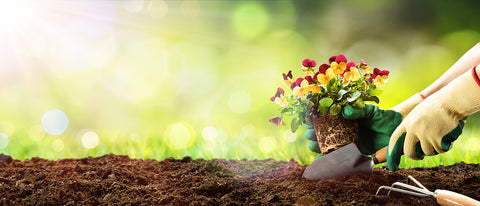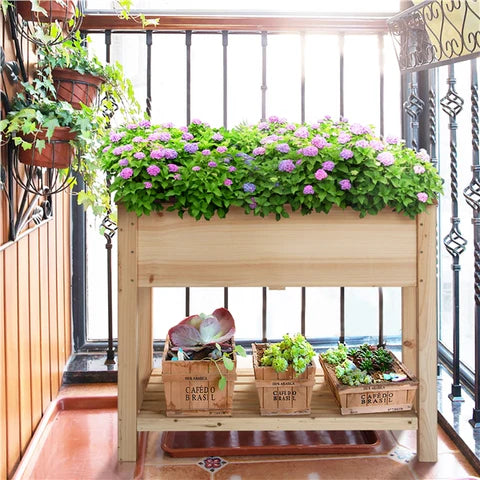
The careful and rational design of planting beds not only enhances soil quality and provides an optimal growing environment, but also serves to save space, streamline management, and enhance the beauty of the garden. When envisioning neatly arranged planting beds with a variety of blooming flowers and plants, it's akin to witnessing a vibrant scroll painting that brings joy to onlookers as they are surrounded by colorful flora. Therefore, in our pursuit to create an enchanting garden, let us recognize the significance of well-designed planting beds.
Types of Planting Bed

Raised Beds:
These are elevated planting areas created by building a structure to contain soil. Raised beds offer better drainage, warmer soil, and easier access for planting and maintenance.
Application Scenario:
- Improved Drainage: Raised beds offer superior drainage compared to traditional in-ground planting, benefiting areas with heavy rainfall, clay soil, or water pooling. The raised structure allows for more effective water drainage, preventing waterlogging and root rot.
- Accessibility: Raised planting beds are an excellent option for gardeners with mobility limitations, reducing the need for bending or kneeling. The elevated height makes planting, weeding, and harvesting more accessible and comfortable, particularly for seniors or individuals with disabilities.
- Extended Growing Season: The soil in raised beds warms up faster in the spring, enabling earlier planting and a prolonged growing season. This is advantageous in cooler climates or for gardeners seeking to maximize their harvest time.
- Pest Control: Raised beds can help deter pests like slugs, snails, and burrowing animals due to the elevated structure creating a barrier between the soil and potential invaders. This can reduce plant damage and minimize the need for chemical pest control methods.

In-Ground Beds:
These are traditional planting areas directly in the ground. They are suitable for most plants and can be easily integrated into the landscape.
Application Scenario:
- Large Garden Spaces: In-ground beds are optimal for expansive garden areas with ample room for cultivating plants directly in the ground. They are well-suited for extensive landscapes, backyard gardens, or community gardens where traditional gardening methods can be utilized.
- Established Soil: In-ground beds are suitable for areas with fertile, well-draining soil that promotes plant growth. If the existing soil is healthy and nutrient-rich, planting directly in the ground can be an economical and sustainable gardening choice.
- Native Plant Gardens: In-ground beds are ideal for cultivating native plants that are well-adapted to local soil and climate conditions. Planting these species directly in the ground can support biodiversity, attract pollinators, and establish a resilient and sustainable garden ecosystem.

Container Beds:
Plants are grown in containers or pots, which can be placed anywhere in the garden or on patios and balconies. Container beds allow for mobility and flexibility in plant arrangement.
Application Scenario:
- Small Spaces: Container planting beds are perfect for small spaces such as balconies, patios, or urban gardens where traditional in-ground planting may not be possible. They allow individuals with limited outdoor space to still enjoy gardening and growing plants.
- Renters: For individuals who rent their living space and may not have the ability to plant directly in the ground, container planting beds offer a portable and temporary gardening solution. They can be easily moved when changing residences.
- Seasonal Planting: Container planting beds are ideal for growing seasonal plants or vegetables that may need to be moved indoors during colder months. They provide flexibility in adjusting to changing weather conditions and extending the growing season.
- Decorative Displays: Containers come in a variety of shapes, sizes, and materials, making them perfect for creating decorative plant displays. Container planting beds can add visual interest and enhance the aesthetic appeal of outdoor spaces, such as porches, decks, or entryways.

Vertical Beds:
Vertical planting beds are mounted on walls or structures, allowing for vertical gardening and maximizing space utilization. They are great for growing climbing plants and adding a vertical dimension to your garden.
Application Scenario:
- Limited Space: Vertical plant beds are perfect for maximizing growing area in small or confined spaces, such as balconies, patios, or urban environments. They enable gardeners to vertically cultivate a variety of plants, making use of unused wall space.
- Privacy Screening: Vertical plant beds can serve as privacy screens or barriers in outdoor settings. By cultivating tall plants or vines on a vertical structure, you can obstruct views, diminish noise, and establish a more secluded and intimate space.
- Indoor Gardening: Vertical plant beds can be utilized indoors to introduce greenery into interior spaces, such as homes, offices, or public buildings. They can enhance indoor air quality, reduce stress, and create a biophilic environment that promotes well-being.

Planting Tips
- Selecting a suitable location: Planting beds should be placed in a sunny, well-ventilated location to promote plant growth. Avoid areas with waterlogging or shade, as this can lead to plant diseases and hinder growth.
- Soil preparation: Before planting, ensure that the soil is rich in nutrients, well-drained, and loose. Organic fertilizers or humus can be added to improve soil texture and provide the necessary nutrients for the plants.
- Planning planting layout: Based on the plant's growth requirements and the size of the space, plan the layout of the planting beds appropriately. Consider the plant's height, growth habits, and sunlight requirements to ensure they have sufficient space and resources for growth.
- Regular watering: Keep the soil in the planting beds moist but not overly wet, and water regularly to meet the plant's water needs. Avoid watering during intense sunlight to reduce the risk of water evaporation and leaf scorch.
- Weeding and pest control: Regularly remove weeds to keep the planting beds tidy and promptly identify and address pest and disease issues. Organic pest control methods, such as manual insect removal or spraying natural insecticides, can be employed to maintain plant health.
- Pruning and maintenance: Regularly prune plants to promote new growth and achieve an attractive plant form. Removing dead branches and fallen leaves helps maintain the cleanliness and ventilation of the planting beds, reducing the proliferation of pests and diseases.

Conclusion
Various types of planting beds and methods can cater to the specific requirements of different plants, facilitating their growth and development. By understanding the information shared above, we aim to select the suitable planting bed type and method to create an optimal environment for plant growth.
